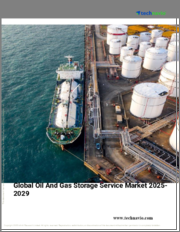
|
시장보고서
상품코드
1635485
유럽의 석유 및 가스 저장 탱크 시장 : 점유율 분석, 산업 동향, 성장 예측(2025-2030년)Europe Oil and Gas Storage Tank - Market Share Analysis, Industry Trends & Statistics, Growth Forecasts (2025 - 2030) |
||||||
유럽의 석유 및 가스 저장 탱크 시장은 예측 기간 중에 3% 이상의 CAGR로 추이할 전망입니다.

시장은 2020년에 COVID-19의 악영향을 받았습니다. 현재 시장은 유행 전의 수준에 도달하고 있습니다. 또한 천연 가스 소비량 증가가 조사 대상 시장의 성장을 가속할 것으로 예상됩니다.
반면에 투자 및 유지 보수 비용 증가는 예측 기간 동안 시장 성장을 방해할 것으로 예상됩니다. 유럽의 석유 및 가스 저장 탱크 시장에 유리한 성장 기회를 가져다 줄 것으로 예상됩니다. 독일은 예측 기간 동안 큰 성장이 예상됩니다.
유럽의 석유 및 가스 저장 탱크 시장 동향
중류가 큰 성장
유럽에는 세계에서 가장 오래된 역사를 가진 산유국이 있습니다. 이 지역은 세계 최대의 해양 석유 및 가스 시장이기도합니다.
중류 부문은 채굴된 원유·천연가스의 수송과 저장에 관계합니다. 석유 및 가스 생산 증가와 인프라의 노후화가 새로운 중류 인프라 수요를 촉진해, 유럽에 있어서의 저장 탱크 수요를 증대시키고 있습니다.
2022년 7월 현재 유럽연합의 가스저장량은 650.4테라와트시(TWh)에 달하고, 용량의 약 89.02%를 차지하고 있습니다.
2022년 5월, Uniper는 독일 당국과 동국 최초의 액화 천연가스(LNG) 터미널을 건설하고, 이 나라가 러시아산 가스에 대한 의존도를 낮출 수 있도록 하는 협정에 조인했습니다. 또, 가스를 수입하기 위한 부체식 저장·재기화 유닛(FSRU) 4기를 전세하는 의향서에도 조인했습니다.
2022년 5월 유럽의 에너지 위기가 심각해짐에 따라 센트리카 PLC는 영국 최대의 천연가스 저장소의 재개권을 취득했습니다. 이전에 추가 규제 당국의 승인을 요청할 수 있습니다.
따라서 위의 요인에 따라 예측 기간 동안 유럽의 석유 및 가스 저장 탱크 시장에서는 중류 부문에 큰 수요가 예상됩니다.
현저한 성장을 이루는 독일
독일에서는 석유 및 가스의 소비가 늘어나고 있기 때문에 저장과 파이프라인의 용량이 완전하게 이용되고 있습니다.
2022년 1월 현재 독일의 전략적 원유 매장량은 원유 환산으로 2,260만 톤입니다. 이것은 2021년 3월 말에 비해 약간 감소했습니다. 적어도 일시적으로 대처할 수 있도록 일정 수준의 원유비축을 확보하는 것을 목표로 하고 있습니다.
2022년 7월 독일과 오스트리아는 가스 저장 시설의 충전을 가속화하는 협정에 조인했습니다. 일에 합의했습니다.
2022년 9월 독일 천연가스 저장시설은 85% 이상에 달했으며 우크라이나 전쟁에서 러시아 공급이 급감했음에도 불구하고 꾸준한 진전을 보였습니다. 달성하기 위한 정부의 목표는 9월 초에 달성되었습니다.
따라서 위의 요인에 따라 독일은 예측 기간 동안 유럽의 석유 및 가스 저장 탱크 시장에서 큰 성장을 이룰 것으로 예상됩니다.
유럽의 석유 및 가스 저장 탱크 산업 개요
유럽의 석유 및 가스 저장 탱크 시장은 적당히 부문화되어 있습니다.
기타 혜택
- 엑셀 형식 시장 예측(ME) 시트
- 3개월간의 애널리스트 서포트
목차
제1장 서론
- 조사 범위
- 시장의 정의
- 조사의 전제
제2장 주요 요약
제3장 조사 방법
제4장 시장 개요
- 소개
- 2027년까지 시장 규모와 수요 예측(단위: 10억 달러)
- 최근 동향과 개발
- 정부의 규제와 시책
- 시장 역학
- 성장 촉진요인
- 억제요인
- 공급망 분석
- Porter's Five Forces 분석
- 공급기업의 협상력
- 소비자의 협상력
- 신규 진입업자의 위협
- 대체품의 위협
- 경쟁 기업간 경쟁 관계의 강도
제5장 시장 세분화
- 섹터
- 업스트림
- 미드스트림
- 다운스트림
- 지역
- 독일
- 영국
- 노르웨이
- 스페인
- 기타 유럽
제6장 경쟁 구도
- M&A, 합작사업, 제휴, 협정
- 주요 기업의 전략
- 기업 프로파일
- Royal Vopak NV
- Oiltanking GmbH
- HOYER GmbH
- Vitol Tank Terminals International BV(VTTI)
- Eisenbau Heilbronn GmbH
- Lapesa Grupo Empresarial SL
- GLS Tanks International GmbH
- ROSEN Group
- Dyer Gas GmbH
- Virtor Oy
제7장 시장 기회와 앞으로의 동향
JHS 25.01.31The Europe Oil and Gas Storage Tank Market is expected to register a CAGR of greater than 3% during the forecast period.

The market was negatively impacted by COVID-19 in 2020. Presently, the market has reached pre-pandemic levels. Over the medium term, the growing demand for oil and gas is expected to stimulate the growth of the European oil and gas storage tank market. Furthermore, increasing consumption of natural gas is expected to drive the growth of the market studied.
On the other hand, increased investment and maintenance costs are expected to hamper the growth of the market studied during the forecast period. Nevertheless, investment in the development of storage facilities and new pipelines for improving the storage capacity of tanks is likely to create lucrative growth opportunities for the European oil and gas storage tank market in the forecast period. Germany is expected to witness significant growth during the forecast period. This growth is attributed to the increasing investments, coupled with increasing consumption of oil and gas in the country.
Europe Oil & Gas Storage Tank Market Trends
Midstream to Witness Significant Growth
Europe is home to some of the oldest oil-producing countries in the world. The region is also one of the largest offshore oil and gas markets worldwide. Norway, the United Kingdom, and Russia are some of the major countries in the region's oil and gas industry.
The midstream sector pertains to the transport and storage of crude oil and natural gas extracted. It includes infrastructure such as crude oil and natural gas pipelines, gas treatment plants, natural gas liquefaction plants, and liquefied gas and regasification storage. The growing oil and gas production and aging infrastructure drive the demand for new midstream infrastructure, increasing the demand for storage tanks in Europe.
As of July 2022, the European Union's gas storage volume amounted to 650.4 terawatt-hours (TWh), accounting for approximately 89.02% of its capacity. The quarterly gas storage volume in the European Union reached a decade-peak in January 2020, with nearly 986.65 TWh of natural gas in supply.
In May 2022, Uniper signed an agreement with German authorities to build the country's first liquefied natural gas (LNG) terminal to enable the country to reduce its reliance on Russian gas. The federal government also signed a letter of intent to charter four floating storage and regasification units (FSRUs) to import gas.
In May 2022, Centrica PLC acquired the rights to restart Britain's largest natural gas storage site as Europe's energy crisis intensifies. The award of a license allows COUK (Centrica offshore UK) to seek further regulatory approvals before gas storage operations can commence.
Therefore, based on the above-mentioned factors, the midstream segment is expected to witness significant demand in the European oil and gas storage tank market during the forecast period.
Germany to Witness Significant Growth
Growing oil and gas consumption in Germany has resulted in the complete utilization of storage and pipeline capacities. New oil storage terminals have been planned in the country to cater to the demand from domestic end users.
As of January 2022, Germany had 22.6 million tons of oil equivalent in strategic crude oil reserves. This was a slight decrease compared to the end of March 2021. According to the legal framework in Germany, the government aims to ensure a certain level of crude oil reserves to be able to combat future shortages, at least temporarily.
In July 2022, Germany and Austria signed a deal to accelerate the filling of gas storage facilities. With the signing of a bilateral solidarity agreement, the two countries agreed to cooperate on the use of liquefied natural gas (LNG) infrastructure and storage filling.
In September 2022, Germany's natural gas storage facilities reached more than 85%, showing steady progress despite a drastic reduction in deliveries from Russia amid the war in Ukraine. The government's target to reach 85% storage capacity by October was achieved at the beginning of September.
Therefore, based on the above-mentioned factors, Germany is expected to witness significant growth in the European oil and gas storage tank market during the forecast period.
Europe Oil & Gas Storage Tank Industry Overview
The European oil and gas storage tank market is moderately fragmented in nature. Some of the major players in the market (in no particular order) are Royal Vopak NV, Oiltanking GmbH, HOYER GmbH, Vitol Tank Terminals International BV (VTTI), and Eisenbau Heilbronn GmbH.
Additional Benefits:
- The market estimate (ME) sheet in Excel format
- 3 months of analyst support
TABLE OF CONTENTS
1 INTRODUCTION
- 1.1 Scope of the Study
- 1.2 Market Definition
- 1.3 Study Assumptions
2 EXECUTIVE SUMMARY
3 RESEARCH METHODOLOGY
4 MARKET OVERVIEW
- 4.1 Introduction
- 4.2 Market Size and Demand Forecast in USD billion, till 2027
- 4.3 Recent Trends and Developments
- 4.4 Government Policies and Regulations
- 4.5 Market Dynamics
- 4.5.1 Drivers
- 4.5.2 Restraints
- 4.6 Supply Chain Analysis
- 4.7 Porter's Five Forces Analysis
- 4.7.1 Bargaining Power of Suppliers
- 4.7.2 Bargaining Power of Consumers
- 4.7.3 Threat of New Entrants
- 4.7.4 Threat of Substitute Products and Services
- 4.7.5 Intensity of Competitive Rivalry
5 MARKET SEGMENTATION
- 5.1 Sector
- 5.1.1 Upstream
- 5.1.2 Midstream
- 5.1.3 Downstream
- 5.2 Geography
- 5.2.1 Germany
- 5.2.2 United Kingdom
- 5.2.3 Norway
- 5.2.4 Spain
- 5.2.5 Rest of Europe
6 COMPETITIVE LANDSCAPE
- 6.1 Mergers and Acquisitions, Joint Ventures, Collaborations, and Agreements
- 6.2 Strategies Adopted by Leading Players
- 6.3 Company Profiles
- 6.3.1 Royal Vopak NV
- 6.3.2 Oiltanking GmbH
- 6.3.3 HOYER GmbH
- 6.3.4 Vitol Tank Terminals International BV (VTTI)
- 6.3.5 Eisenbau Heilbronn GmbH
- 6.3.6 Lapesa Grupo Empresarial SL
- 6.3.7 GLS Tanks International GmbH
- 6.3.8 ROSEN Group
- 6.3.9 Dyer Gas GmbH
- 6.3.10 Virtor Oy




















